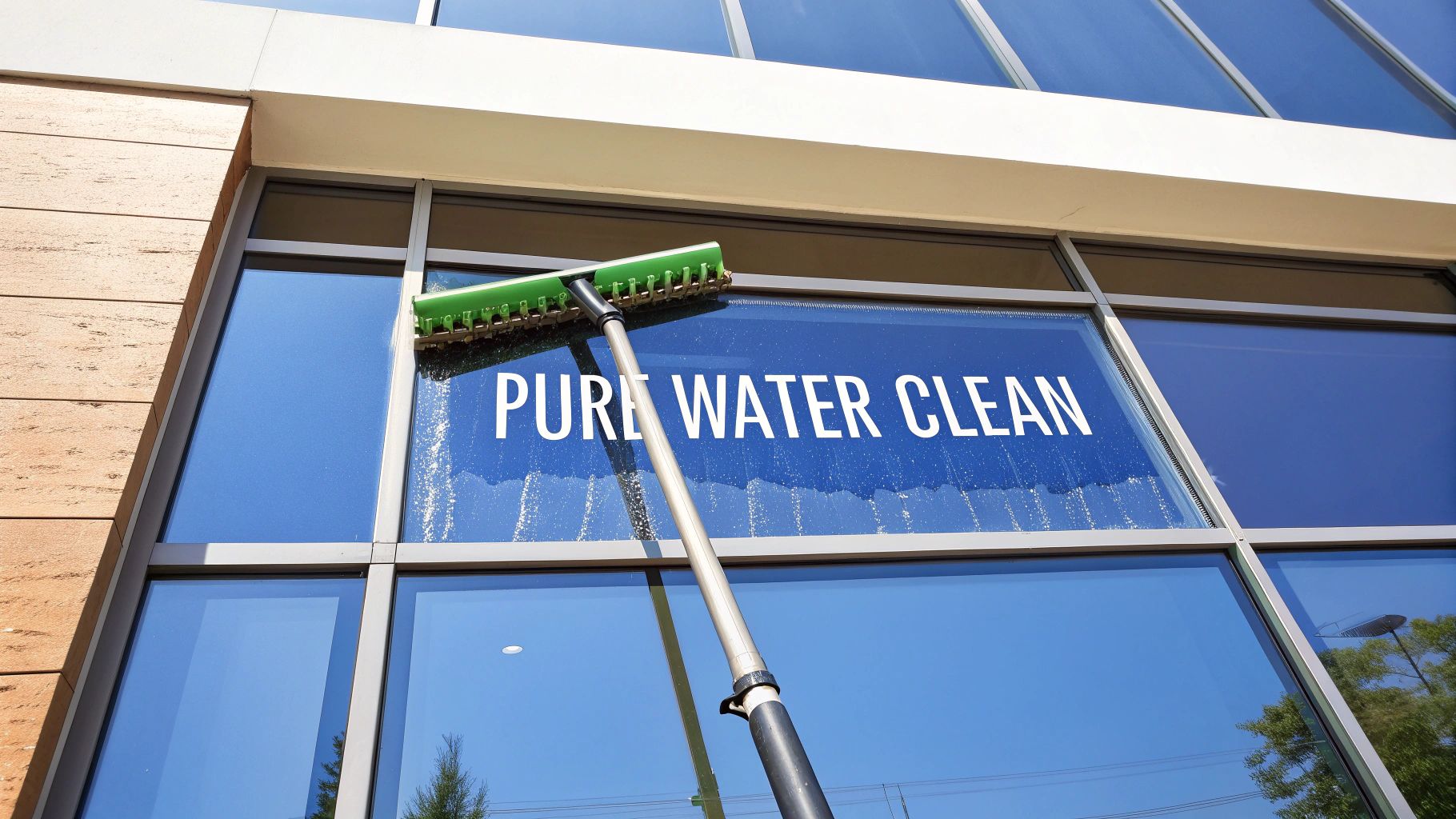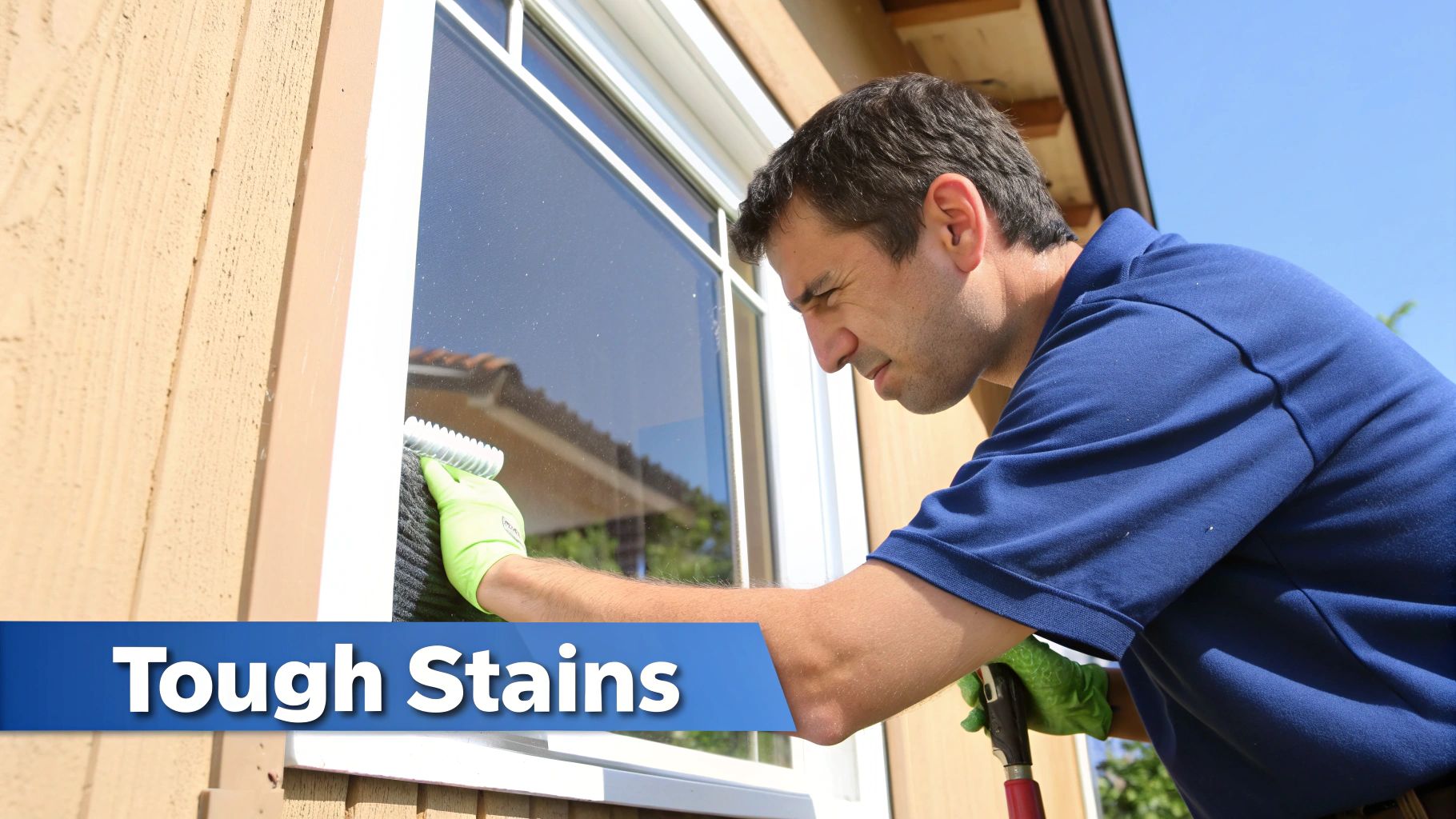Pro tips for how to clean windows without streaks

Getting that perfectly clear, streak-free window often feels like a losing battle, but I promise you, the answer is simpler than you think. The fastest way to learn how to clean windows without streaks is to do what the pros do. We only rely on two methods: the classic squeegee or a modern pure water system. That's it.
The Pro Secrets to a Flawless Finish
Have you ever spent hours cleaning your windows, only to have the sun hit them just right and reveal a mess of smudges and lines? The problem isn’t your effort—it’s your tools. Those paper towels and all-purpose sprays from the grocery store are notorious for leaving behind lint and chemical residue, which create the very streaks you're trying to get rid of.
Professionals know the secret to that "invisible glass" look is all about the right equipment and a proven technique. It's time to forget the frustrating DIY hacks that promise the world and deliver cloudy glass. Let's break down the only two methods professionals use.
The Two Pillars of Professional Window Cleaning
Every single professional window cleaning job, whether it's a small home or a massive office building, boils down to one of two approaches. Each is designed for specific situations, but both deliver the same flawless result.
The Squeegee Method: This is the time-tested technique you see us using on residential homes, interior glass, and storefronts. It’s an art form, really. We apply a simple, effective cleaning solution and then use a high-quality squeegee to pull all the dirt and water off the glass in one clean, fluid motion.
The Pure Water System: For multi-story buildings or windows that are just plain hard to reach, this modern method is a game-changer. It uses highly filtered, deionized water—so pure it contains zero minerals. This water acts like a magnet for dirt, lifting it right off the glass. The best part? It evaporates completely clean, leaving no spots behind. No drying needed.
The core difference is simple: a squeegee physically removes dirty water from the glass, while a pure water system rinses it clean with water so pure it leaves nothing behind when it dries.
To give you a clearer picture, here’s a quick breakdown of how these two methods stack up.
Professional Window Cleaning Methods at a Glance
Ultimately, choosing the right method depends on the job at hand, but both paths lead to the same destination: exceptionally clean windows.
Of course, sparkling glass looks even better when the entire window area is clean. To truly complete the look, don't forget the blinds. You can find some easy tips for cleaning blinds to complement sparkling windows that will make a huge difference.
Mastering the Squeegee for Streak-Free Results
The squeegee is the most iconic tool in window cleaning for one simple reason: when you know how to use it, it works flawlessly. But there's a real art to it, and mastering that skill is what separates frustrating streaks from a perfect, invisible finish. The whole process starts with the right gear and a surprisingly simple cleaning solution.
Forget all those expensive, chemical-heavy sprays you see in stores. All you really need is a bucket of clean water with just a drop of dish soap. This simple mix creates just enough slip for the squeegee to glide smoothly across the glass, lifting away dirt without leaving any residue behind. The real magic, though, is in the technique.
The Essential Tools and Technique
Your success really boils down to a few key items. A high-quality squeegee with a sharp, flexible rubber blade is non-negotiable. You’ll also need a dedicated scrubber to apply your soapy water and several clean, lint-free microfiber towels—one for wiping the blade and a few others for detailing the edges.
The single most critical step that beginners almost always miss is wiping the squeegee blade clean after every single pass. This tiny action stops you from dragging dirty water back across the clean glass, which is the number one cause of streaks.
This is the kind of detail that defines professional work. It's no surprise the window cleaning industry in the United States is booming, with revenues projected to hit $3.2 billion by 2029. Homeowners and businesses alike are willing to pay for that truly professional, streak-free look.
This infographic breaks down the two main methods the pros use to get that flawless finish.

As you can see, there are really two paths to perfectly clean windows: the classic hands-on squeegee method and the more modern pure water system. Each one has its place depending on the job.
Perfecting the Professional S-Method
Once you have your gear ready, it's time to learn the technique pros rely on for both speed and perfect results: the 'S-Method'. This is all about moving the squeegee across the glass in a continuous, fluid S-shaped pattern from top to bottom.
Here's how it's done. Start by creating a "dry edge" by wiping a one-inch strip down one side of the window. Then, place your squeegee at the top corner of the wet glass, angle it down slightly, and pull it across.
As you turn to make the next downward pass, make sure you overlap your previous stroke by about an inch. This overlap is crucial; it's what pulls all the water away without leaving those annoying thin lines between strokes. Remember to maintain light, consistent pressure the whole way down. For a more detailed walkthrough, check out our complete guide on how to squeegee windows like a pro.
Using Pure Water Systems for a Spotless Shine

When you’re dealing with second-story windows or massive glass facades, the traditional bucket and squeegee just won't cut it. This is where a pure water system really shines, offering a safer and far more efficient solution for those hard-to-reach spots on both residential and commercial properties. It completely changes the game.
The secret is in the water itself. We use water that has been pushed through an intense purification process—either reverse osmosis or deionization—to strip out every last mineral and total dissolved solid (TDS). When water is that pure, it acts like a magnet for dirt, actively pulling grime, dust, and pollen right off the glass. No soap or chemical detergents needed.
How Pure Water Delivers That Perfect Finish
The real magic happens during the drying process. Because the water has zero mineral content, it evaporates without leaving anything behind. No deposits, no spots, no streaks. This means we don't even have to squeegee or towel-dry the glass. The result is a flawless, crystal-clear finish every single time.
This method is a lifesaver in areas with notoriously hard water, where mineral deposits make streak-free cleaning a constant battle. Homeowners in places like Las Vegas, for example, are all too familiar with stubborn water spots, making pure water systems a much more reliable choice.
The Tools and Process
The setup is surprisingly straightforward, consisting of a filtration system and a water-fed pole. These lightweight, extendable poles let our technicians clean windows several stories high while keeping their feet safely on the ground.
- The Pole: A telescopic water-fed pole delivers a steady stream of pure water directly to the window.
- The Brush: A soft-bristled, non-abrasive brush at the end of the pole gently agitates and scrubs away stubborn grime without scratching the glass.
- The Rinse: After a good scrub, we give the window a final, low-pressure rinse with more pure water, washing away all the loosened debris and leaving the surface immaculate.
The key takeaway is the rinse. A thorough final rinse is what ensures every speck of dirt is washed away, allowing the pure water to evaporate and leave nothing but a perfectly clean window behind.
The demand for these effective, high-reach solutions is driving serious growth in the cleaning industry. The global building window cleaning systems market, currently valued at USD 1.5 billion, is projected to more than double. This boom is fueled by the need for safer, more consistent results, especially on large commercial properties like those in downtown Phoenix, where high-efficiency systems are becoming the new standard. You can read more about the growth in window cleaning systems on Credence Research.
Tackling Tough Window Cleaning Challenges

Even when you’ve got the best tools and a solid technique, the real world loves to throw curveballs. Sun, stubborn stains, and overlooked details can mess up an otherwise perfect job. Knowing how to handle these common challenges is what separates the amateurs from the pros.
One of the most frequent headaches is trying to clean windows in direct sunlight. The sun’s heat causes your cleaning solution to evaporate almost instantly, leaving behind ugly streaks before you even have a chance to squeegee. The trick here is to work faster and in smaller, more manageable sections.
Instead of soaking the whole window, just wet one small area at a time. Squeegee it dry immediately, then move on to the next spot. This keeps the solution from drying prematurely and gives you a fighting chance at a flawless finish.
Dealing with Stubborn Hard Water Stains
Hard water stains are the bane of any window cleaner’s existence, particularly in places with high mineral content in the water. Those chalky white spots are mineral deposits left behind when water evaporates, and your standard soap-and-water mix won't touch them. This is a common problem for properties around cities like Denver, where the water can be notoriously hard.
To break down these minerals, you'll need something acidic. For light staining, a simple mix of equal parts white vinegar and water often works wonders.
For more serious mineral buildup, you’ll likely need a specialized hard water stain remover. Apply it with a non-abrasive pad, gently work it into the spots, and then clean the window like you normally would.
If you find yourself battling persistent mineral deposits, our in-depth guide offers more advanced techniques on how to remove water spots from glass for good.
Don't Forget the Details
A truly clean window is more than just sparkling glass. If you ignore the surrounding elements, you can undermine all your hard work. Taking a few extra minutes to address these often-forgotten areas makes for a complete, professional-looking job.
- Window Tracks: Grab a stiff brush to loosen all the gunk and debris, then use a vacuum to suck it all out. A final wipe with a clean cloth finishes the job.
- Screens: Gently scrub your screens with soapy water and give them a good rinse. Make sure they are 100% dry before putting them back in place.
- Sills and Frames: The final touch is a quick wipe-down of the sills and frames with a clean microfiber cloth. This catches any drips and dust, perfectly framing your gleaming glass.
When to Call a Professional Window Cleaner
While DIY methods are great for keeping things tidy between professional visits, some jobs are simply best left to the experts. Knowing how to clean windows without streaks is one piece of the puzzle, but safely getting to them is a whole different ball game.
Think about it: tackling windows on a multi-story building, reaching awkward skylights, or leaning out over a tricky ledge poses serious safety risks without specialized training. Pros come equipped with gear like pure water systems and safety harnesses to handle these situations safely and efficiently.
They also have the experience for the really tough stuff, like post-construction cleanup. Getting stubborn materials like paint overspray or adhesive residue off glass without scratching it is a skill learned over years in the field.
Beyond Safety and Skill
Let's be honest, beyond the safety issues, there's the value of your time. If you're a busy homeowner or managing a large commercial property, the hours you'd spend on windows are often better invested elsewhere. The efficiency of a professional service is a worthy investment.
The demand for this expertise is growing fast. The global window cleaners market was valued at USD 2.68 billion and is projected to more than double by 2031. It's clear that more people are recognizing the value pros bring to the table.
For particularly large or complex window cleaning projects, or when professional-grade results are consistently needed, it can be beneficial to consider how to choose commercial cleaning services.
Ultimately, hiring a professional ensures a flawless, long-lasting finish and frees up your valuable time. To get a better idea of the advantage they bring, check out our guide on what professional window cleaners use.
Still Have Questions About Getting Streak-Free Windows?
Even with the best guide, a few questions always come up. Let's tackle some of the most common ones we hear from folks trying to get that perfect, professional shine for the first time.
Why Do My Windows Still Have Lines?
If you're using a squeegee and still seeing streaks, it almost always boils down to one of three culprits: a damaged blade, not overlapping your strokes, or forgetting to wipe the blade.
Even a tiny, invisible nick in the rubber will drag a line of dirty water down the glass every single time. Make sure you overlap each pull by about an inch, and—this is crucial—always wipe the blade clean with a microfiber cloth after every single stroke.
Can I Just Use Vinegar and Newspaper?
This is a classic DIY myth, but you'll never see a professional using this method. Vinegar is acidic, and over time it can actually eat away at your window seals and damage the frames.
And the newspaper? The ink often smudges and transfers, leaving you with black marks all over the glass, your frames, and your hands. A quality squeegee paired with a simple solution of water and a single drop of dish soap is far more effective and much safer for your windows.
When Is the Best Time to Clean Windows?
Always try to clean your windows on an overcast day. Direct sunlight is your biggest enemy here because it heats up the glass, causing your cleaning solution to evaporate before you have a chance to squeegee it off.
That rapid drying is one of the main reasons streaks form. If you absolutely have to clean in the sun, you'll need to work much faster and in smaller, more manageable sections to beat the heat.
For a flawless finish without all the guesswork, you can always trust the experts at Professional Window Cleaning. Find out more or get a free estimate at our website: https://www.professionalwindowcleaning.com.
Related articles
Read our blog posts regularly and keep learning.




